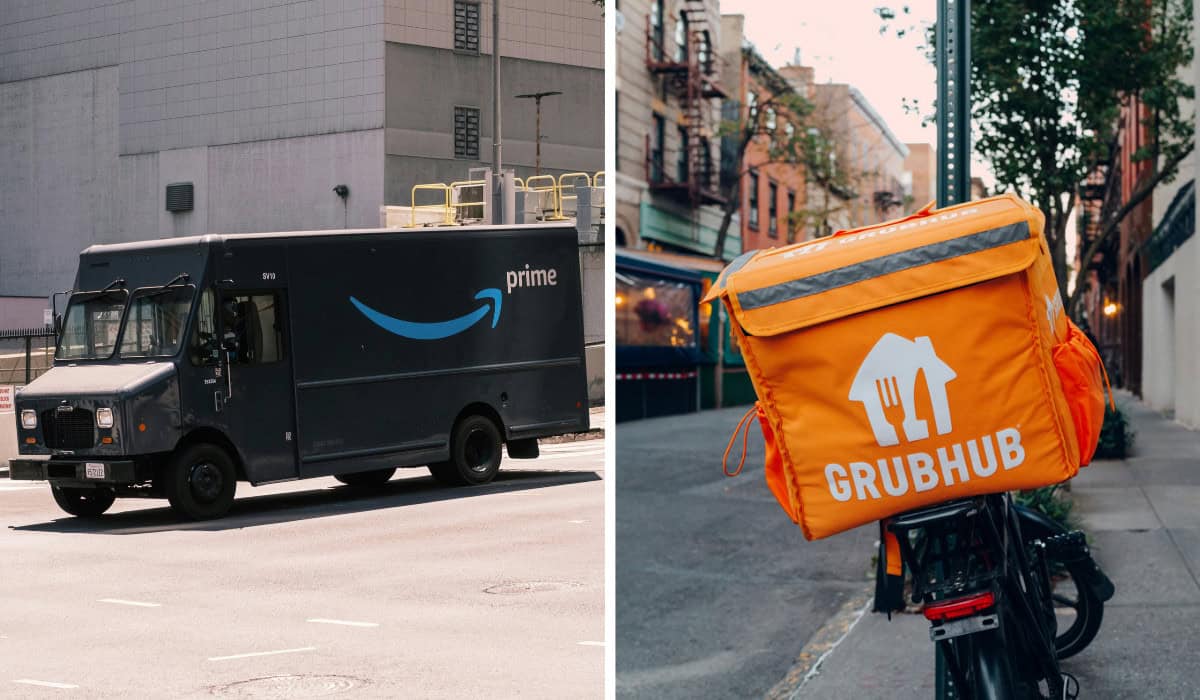
Photo by Andrew Stickelman on Unsplash | iStock.com/Alena Kravchenko
Will Amazon Take Over the Restaurant Delivery Industry?
Amazon has expanded its Prime membership to include a permanent Grubhub+ subscription, offering benefits like $0 delivery fees on orders over $12, lower service fees, 5% credit back on pick-up orders, and exclusive offers. This change follows a previous offer of a free year-long Grubhub subscription for Prime members. Additionally, Prime members can now order Grubhub through Amazon’s website and app.
To celebrate, Prime members can use the code “PRIME5” for $5 off a Grubhub order over $25 until June 2. This move is part of Amazon’s strategy to attract customers amid competition from Walmart and Target. Amazon also has a 2% stake in Grubhub, with the potential to increase it to 15% based on performance, such as “the new number of customers added,” according to CNBC.
Amazon’s partnership with Grubhub aims to help the retailer recover from its previous unsuccessful Amazon Restaurants venture and to diversify its revenue streams. Despite the benefits, Amazon will face competition from Target’s similar service, Project Trident, which integrates its own delivery service, Shipt. Target, however, has reported a decline in sales, emphasizing the need for retailers to keep their offerings diverse.
But this isn’t the first time Amazon has made a play in the restaurant delivery industry. In 2015, from Seattle, Amazon attempted to take on Grubhub and Uber Eats directly as a new option for Prime members. Four years later, the endeavor failed.
The closure of Amazon Restaurants marked a significant retreat for the e-commerce giant in the fiercely competitive food delivery market. Despite its initial ambitions, Amazon struggled to gain a foothold against established players.
A comprehensive analysis of the food delivery landscape revealed why Amazon likely decided to exit the market. Data showed that Amazon Restaurants was significantly outnumbered by its competitors. For example, in Los Angeles, Amazon Restaurants serviced only 126 restaurants compared to 15,733 restaurants catered by DoorDash, Uber Eats, Grubhub, and Postmates combined. Similarly, in New York, often regarded as the food delivery capital of the U.S., Amazon Restaurants supported 485 restaurants, whereas its competitors collectively served 22,062.
Nationally, the disparity was even more stark. By the end of its run, Amazon Restaurants had partnered with 6,235 restaurants across the U.S., a stark contrast to the 842,746 restaurants served by its competitors, resulting in a staggering ratio of 135:1. This overwhelming difference in service coverage underscored why Amazon’s venture into food delivery could not sustain itself against more entrenched players.
Despite this setback, it was premature to assume that Amazon had permanently exited the food delivery business. Amazon demonstrated its continued interest in the sector by leading a $575 million investment in Deliveroo, a leading European food delivery service. Deliveroo, which dominated the U.K. and European markets, operated in a manner akin to Grubhub’s extensive reach in the U.S.
Then, in 2022, Amazon acquired the rights to purchase a 2% stake in Grubhub. Now, it’s been revealed that Amazon has received warrants representing 4% of Grubhub’s equity, with the potential to acquire an additional 10% based on certain conditions. This move comes after Just Eat Takeaway’s acquisition of Grubhub in 2020 in an all-stock deal valued at $7.3 billion.
Amazon’s interest in Grubhub aligns with its strategy to tap into the lucrative food delivery market, especially with the growing number of Amazon Prime members in the U.S., which stood at around 180 million as of March 2024, according to Consumer Intelligence Research Partners.
Just Eat acknowledged its endeavor toward either a partial or complete divestiture of Grubhub. Amazon has the opportunity to elevate its stake in Grubhub to 15%. The arrangement between Amazon and Just Eat will undergo renewal annually unless either entity opts to cease it.
Grubhub, however, has faced challenges in the U.S. restaurant delivery market, capturing only 8% of all U.S. meal delivery sales as of March. In contrast, DoorDash leads the market with 67% of meal delivery sales, followed by Uber with an estimated 25%, according to Bloomberg Second Measure.
Discussion Questions
How might Amazon’s latest partnership with Grubhub reshape the landscape of food delivery services, particularly in light of its previous setbacks with Amazon Restaurants?
With Amazon’s increasing stake in Grubhub, what implications might this have for the competition among major retailers such as Walmart and Target who are also venturing into the meal delivery market?
Considering the challenges Grubhub has faced in the U.S. restaurant delivery market, what strategies could it employ to regain its competitive edge against industry leaders like DoorDash and Uber Eats?
